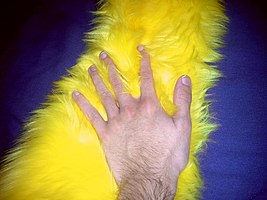Stimming

Self-stimulatory behavior, also known as "stimming"[1] and self-stimulation,[2] is the repetition of physical movements, sounds, words, moving objects, or other behaviors. Stimming is a type of restricted and repetitive behavior (RRB).[3] Such behaviors (also scientifically known as "stereotypies") are found to some degree in all people, but is especially intense and frequent in those with developmental disabilities, attention deficit hyperactivity disorder (ADHD) or autism.[2] People diagnosed with sensory processing disorder are also known to potentially exhibit more stimming behaviors.[4]
Stimming has been interpreted as a protective response to overstimulation, in which people calm themselves by blocking less predictable environmental stimuli, to which they have a heightened sensitivity.[2][4] A further explanation views stimming as a way to relieve anxiety and other negative or heightened emotions.[5]

Although some forms of stimming behaviors have typically been shown to be healthy and beneficial—as they help regulate intense sensory experiences, relieve intense emotions such as anxiety, may facilitate understanding and social interactions with other autistic people, may promote pleasant emotions, and facilitate sense of security—[6][7][8][9][10] stimming is often socially stigmatized and looked down upon. People who are neurodivergent often feel that they need to hide or decrease their repetitive behaviors, as it appears to not be socially acceptable, and often elicits an undesirable response from those who do not understand the needs or functions behind them. While reducing disruptive or inherently harmful repetitive behaviors can be crucial,[11][12][13] there are also potential risks to mental health and well-being in suppressing and masking some autistic stimming behaviors that are generally not harmful or generally adaptive.[7][14][10][9][15][16][8]
Stimming behaviors can consist of tactile, visual, auditory, vocal, proprioceptive (which pertains to limb sensing), olfactory, and vestibular stimming (which pertains to balance). Some common examples of stimming (sometimes called stims[17]) include hand flapping, clapping, rocking, blinking, pacing, head banging, repeating noises or words, snapping fingers, occasional toe walking, or spinning objects.[18][19] In some cases, stimming may be dangerous and physically harmful to the person doing it; for example, individuals may risk injuring themselves by forcefully banging their body parts against walls.[20] Another issue is that repetitive behaviors can disrupt learning and social communication for some autistic individuals in some situations.[21][22]
Autism
[edit]
Stimming behavior is almost always present in autistic people, but does not, on its own, necessarily indicate the diagnosis.[9][23] The biggest difference between autistic and non-autistic stimming is the type of stim and the quantity of stimming.[23] In the Diagnostic and Statistical Manual of Mental Disorders, published by the American Psychiatric Association, stimming behavior is described as "stereotyped or repetitive motor mannerisms" and listed as one of the five key diagnostic criteria of autism spectrum disorder.[24]
Different perspectives suggest that stimming involves both sensory and motor functions. Underdevelopment of these sensorimotor functions can result in stimming behaviors produced by the person as a controllable response. One study which interviewed thirty-two autistic adults found that unpredictable and overwhelming environments caused stimming.[14]
Stimming can sometimes be self-injurious, such as when it involves head-banging, hand-biting, excessive self-rubbing, and scratching the skin.[25]
As it serves the purpose of self-regulation and is mostly done subconsciously, stimming is difficult to suppress.[26] Managing the sensory and emotional environment while increasing the amount of daily exercise can increase comfort levels for the person, which may reduce the amount of the need for stimming.[27] Consciously or subconsciously suppressing stimming with the aim to present as neurotypical is one type of autistic masking.[28][29] It typically requires an exceptional effort and can negatively impact mental health and well-being.[28][29][30]
ADHD
[edit]Stimming is practiced by some, but not all, people with ADHD.[31] The cause is not thoroughly understood, but experts believe stimming is likely linked to the effects of the dopamine imbalance that occurs in the brains of people with ADHD.[32] Some of the reasons people with ADHD might stim include to help them focus, to process and deal with their emotions, to help to deal with boredom, to express excitement, to cope with being overwhelmed by their environment, and to help them concentrate when they are uninterested with a topic or task.[33]
The behaviors associated with ADHD stimming are characteristically repetitive and can be done consciously or unconsciously.[33] Many neurotypical people may exhibit the same stimming behaviors, referred to as fidgeting, as someone with ADHD. However, for people with ADHD, these behaviors are more severe, occur more often, and can affect the person’s daily lives.[32] Some potentially more negative or harmful stimming behaviors include teeth grinding, biting one's fingernails and lips, picking at one’s skin and scabs, overeating, impulsive actions, and chewing the inside of the cheeks.[33]
For people with ADHD, stimming can change over time. Some stims may lessen or disappear over time, while other stims can emerge as the result of other stressors.[31] ADHD symptoms can be aggravated by certain environments, situations, and emotions, which will trigger stimming behavior. Some of these triggers include situations involving certain emotions like conflict and rejection, distractions caused by television and phones, environments that are messy or busy, strong or distracting odors, and intense lighting.[33]
Toys
[edit]Small objects known as stim toys or sensory toys may be used to satisfy a person's stimming behaviours. A stim toy may be specially designed for a specific stimming behaviour, such as a fidget toy, or it may be any ordinary object that a person can manipulate to perform the desired stimming behaviour. Many popular stim toys are held in the hands; they may also provide oral stimulation, such as chewelry.[34][35]
See also
[edit]References
[edit]- ^ Bergemann, Rosalind (2013). An Asperger Leader's Guide to Living and Leading Change. Jessica Kingsley Publishers. ISBN 978-0-85700-872-5.[page needed]
- ^ a b c Foley, Valerie (2011). The Autism Experience: International Perspectives on Autism Parenting. ReadHowYouWant.com. ISBN 978-1-4587-9728-5.[page needed]
- ^ American Psychiatric Association. (2013). Diagnostic and statistical manual of mental disorders (5th ed.). Washington, DC: Author
- ^ a b Cowell, Gretchen Mertz (2004). Help for the Child with Asperger's Syndrome: A Parent's Guide to Negotiating the Social Service Maze. Jessica Kingsley Publishers. ISBN 978-1-84642-042-9.[page needed]
- ^ Eileen Bailey (15 July 2011). "Autism Spectrum Disorders and Anxiety". Health Central. Retrieved 25 March 2014.
- ^ Morris, Isabelle F.; Sykes, Jesica R.; Paulus, Emilie R.; Dameh, Alharith; Razzaque, Aysha; Esch, Lauren Vander; Gruenig, Jenna; Zelazo, Philip David (2025). "Beyond self-regulation: Autistic experiences and perceptions of stimming". Neurodiversity. 3. doi:10.1177/27546330241311096.
- ^ a b Lung, Stephanie Lock Man; Picard, Ève; Soulières, Isabelle; Bertone, Armando (September 2024). "Identifying the functions of restricted and repetitive behaviours and interests in Autism: A scoping review". Research in Autism Spectrum Disorders. 117: 102458. doi:10.1016/j.rasd.2024.102458.
- ^ a b Collis, Emma; Dark, Elizabeth; Russell, Ailsa; Brosnan, Mark (30 August 2024). "Self-Report of Restricted Repetitive Behaviors in Autistic Adults: A Systematic Review". Autism in Adulthood. doi:10.1089/aut.2023.0111.
- ^ a b c Charlton, Rebecca A.; Entecott, Timothy; Belova, Evelina; Nwaordu, Gabrielle (November 2021). "'It feels like holding back something you need to say': Autistic and Non-Autistic Adults accounts of sensory experiences and stimming" (PDF). Research in Autism Spectrum Disorders. 89: 101864. doi:10.1016/j.rasd.2021.101864.
- ^ a b Collis, E.; Gavin, J.; Russell, A.; Brosnan, M. (February 2022). "Autistic adults' experience of restricted repetitive behaviours" (PDF). Research in Autism Spectrum Disorders. 90: 101895. doi:10.1016/j.rasd.2021.101895.
- ^ Morris, Isabelle F.; Sykes, Jesica R.; Paulus, Emilie R.; Dameh, Alharith; Razzaque, Aysha; Esch, Lauren Vander; Gruenig, Jenna; Zelazo, Philip David (2025). "Beyond self-regulation: Autistic experiences and perceptions of stimming". Neurodiversity. 3. doi:10.1177/27546330241311096.
- ^ Ne'eman, A (July 2021). "When Disability Is Defined by Behavior, Outcome Measures Should Not Promote 'Passing'". AMA Journal of Ethics. 23 (7): E569–575. doi:10.1001/amajethics.2021.569. PMC 8957386. PMID 34351268.
- ^ Allen, Lauren Lestremau; Mellon, Leanna S.; Syed, Noor; Johnson, Joy F.; Bernal, Armando J. (25 March 2024). "Neurodiversity-Affirming Applied Behavior Analysis". Behavior Analysis in Practice. doi:10.1007/s40617-024-00918-0.
- ^ a b Kapp, Steven K; Steward, Robyn; Crane, Laura; Elliott, Daisy; Elphick, Chris; Pellicano, Elizabeth; Russell, Ginny (October 2019). "'People should be allowed to do what they like': Autistic adults' views and experiences of stimming". Autism. 23 (7): 1782–1792. doi:10.1177/1362361319829628. PMC 6728747. PMID 30818970.
- ^ McCormack, Lynne; Wong, Sze Wing; Campbell, Linda E. (September 2023). "'If I don't Do It, I'm Out of Rhythm and I Can't Focus As Well': Positive and Negative Adult Interpretations of Therapies Aimed at 'Fixing' Their Restricted and Repetitive Behaviours in Childhood". Journal of Autism and Developmental Disorders. 53 (9): 3435–3448. doi:10.1007/s10803-022-05644-6. PMC 10465631. PMID 35781855.
- ^ Waizbard-Bartov, Einat; Ferrer, Emilio; Heath, Brianna; Andrews, Derek S; Rogers, Sally; Kerns, Connor M; Wu Nordahl, Christine; Solomon, Marjorie; Amaral, David G (May 2024). "Changes in the severity of autism symptom domains are related to mental health challenges during middle childhood". Autism. 28 (5): 1216–1230. doi:10.1177/13623613231195108. PMC 10924781. PMID 37691349.
- ^ Temple Grandin, PhD (November 2011). "Why Do Kids with Autism Stim?". Autism Digest. Archived from the original on 31 March 2014. Retrieved 25 March 2014.
- ^ Eileen Bailey (27 August 2012). "Stimming". Health Central. Retrieved 25 March 2014.
- ^ "Stimming: What autistic people do to feel calmer". BBC. 5 June 2013. Retrieved 25 March 2014.
- ^ Smith, Lori; Legg, Timothy J. (19 February 2018). "What is stimming?". Medical News Today. Retrieved 19 April 2022.
For some, stimming can include higher-risk behaviors such as banging their hands, head, legs, and objects, which may be potentially physically harmful.
- ^ Lanovaz, Marc J.; Robertson, Kirsty M.; Soerono, Kara; Watkins, Nicholas (October 2013). "Effects of reducing stereotypy on other behaviors: A systematic review". Research in Autism Spectrum Disorders. 7 (10): 1234–1243. doi:10.1016/j.rasd.2013.07.009. hdl:1866/19828.
- ^ Leaf, Justin B.; Cihon, Joseph H.; Javed, Asim; Klick, Sheila; Ferguson, Julia L.; Milne, Christine; Creem, Ashley; Arthur, Shannon; Saunders, Melissa, S.; Olive, Melissa L.; Ross, Robert K.; Leaf, Ronald; McEachin, John (3 July 2022). "A call for discussion on stereotypic behavior". European Journal of Behavior Analysis. 23 (2): 156–180. doi:10.1080/15021149.2022.2112810.
{{cite journal}}: CS1 maint: multiple names: authors list (link) - ^ a b Rudy, Lisa Jo (13 October 2009). "Stimming". About.com. Archived from the original on 30 March 2014. Retrieved 24 March 2014.
- ^ Diagnostic and statistical manual of mental disorders : DSM-5 (5 ed.). Arlington, VA: American Psychiatric Association. 2013. ISBN 978-0-89042-554-1. OCLC 830807378.[page needed]
- ^ "ADHD Stimming vs Autism Stimming: What's the Difference?". www.crossrivertherapy.com. Retrieved 25 July 2024.
- ^ Devita-Raeburn, Elizabeth (10 August 2016). "The controversy over autism's most common therapy". Spectrum News. Simons Foundation. Retrieved 7 April 2023.
- ^ Cunningham, Allison B.; Schreibman, Laura (July 2008). "Stereotypy in autism: The importance of function". Research in Autism Spectrum Disorders. 2 (3): 469–479. doi:10.1016/j.rasd.2007.09.006. PMC 2598746. PMID 19122856.
- ^ a b Pearson, Amy; Rose, Kieran (March 2021). "A Conceptual Analysis of Autistic Masking: Understanding the Narrative of Stigma and the Illusion of Choice". Autism in Adulthood. 3 (1): 52–60. doi:10.1089/aut.2020.0043. PMC 8992880. PMID 36601266.
- ^ a b Hull, Laura; Petrides, K. V.; Allison, Carrie; Smith, Paula; Baron-Cohen, Simon; Lai, Meng-Chuan; Mandy, William (August 2017). "'Putting on My Best Normal': Social Camouflaging in Adults with Autism Spectrum Conditions". Journal of Autism and Developmental Disorders. 47 (8): 2519–2534. doi:10.1007/s10803-017-3166-5. PMC 5509825. PMID 28527095.
- ^ "6A02 Autism spectrum disorder". icd.who.int. ICD-11 for Mortality and Morbidity Statistics. 2022. Retrieved 7 April 2023.
- ^ a b Zauderer, Steven. "ADHD Stimming vs Autism Stimming: What's the Difference?". www.crossrivertherapy.com. Retrieved 25 July 2024.
- ^ a b Team, ADDA Editorial (26 April 2023). "ADHD Stimming: Why It Happens and How to Cope". ADDA - Attention Deficit Disorder Association. Retrieved 25 July 2024.
- ^ a b c d Vevers, Sarah (15 January 2024). "ADHD stimming: Definition, examples, triggers, and more". www.medicalnewstoday.com. Retrieved 25 July 2024.
- ^ "Chewelry Chewable Jewelry for Autism and Special Needs Kids".
- ^ Unmasking Autism: Discovering the New Faces of Neurodiversity. Harmony/Rodale. 5 April 2022. ISBN 978-0-593-23524-9.
